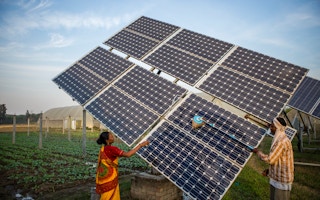In the spring of 1992, in the basement of the UN Headquarters in New York City, Al Gore, a young senator from Tennessee, was among the many observers of the concluding preparations for the Rio de Janeiro Earth Summit.
Mr Gore had just published a book entitled “Earth in Balance” and he was curious to see how the folks at the UN were faring. What he found was incredible enthusiasm and an outburst of new ideas. Multilateralism had reached new heights. The end of the Cold War had given rise to new optimism. There was talk of a “peace dividend”. And all governments understood the imperative of international cooperation.
The historic Rio de Janeiro Earth Summit of 1992, which was in part inspired by the 1987 Montreal Protocol on Substances that Deplete the Ozone Layer, produced major breakthroughs, including an international environmental treaty, the United Nations Framework Convention on Climate Change.
But the momentum created by the Rio Summit fizzled out in subsequent years. The peace dividend never materialised, and the subsequent climate negotiations were largely inconsequential.
Emissions continued to rise despite growing scientific evidence of their damaging consequences for human life and the natural environment. Governments continued to promote narrow concepts of growth based on fossil fuels, which account for about 80 per cent of the emissions that cause global warming, while largely ignoring the cost of emissions. The tragic events of 9/11 and the subsequent invasion of Iraq brought new divides which further undermined the foundations of international cooperation.
In 2015, after more than two decades of failed climate diplomacy, a new climate treaty, the Paris Agreement, was at last forged, enabled by the willingness of the United States and China to collaborate. By then it was understood that urgent action was necessary to keep global warming well below 2 degrees Celsius to avoid catastrophic damage.
Alas, emissions continued to rise after 2015. While the European Union carried forward the good spirits of cooperation and climate action, many countries fell victim to the spread of populism and economic nationalism. Their myth-based policies further undermined cooperation and often destructed accomplishments made so far. Even most of the countries who had pledged to adhere to the Paris Agreement failed to make sufficient progress. Centrist policy makers viewed climate action as a political liability associated with enormous social and economic costs.
After decades of incremental but insufficient progress, climate change is now reaching a tipping point. The announcement by President-elect Joe Biden to prioritise climate action and China’s commitment to become carbon neutral, along with the European Union’s ambitions to become the first carbon-neutral continent, and commitments by Japan, Korea and other countries, suggest that policy makers are increasingly prepared to change course.
Sceptics may argue that these are empty promises with little practical meaning. Governments routinely sign goodwill declarations while lacking the willingness or ability to deliver. After all, it is easy to make promises that will not have to be realised until far into the future. But there are at least five good reasons why this time around, a systems change is in the making:
Growing public awareness. Numerous voluntary initiatives around the globe have shifted public awareness of the growing scientific and physical evidence of climate change. For example, Al Gore and the Intergovernmental Panel on Climate Change (IPCC) received the Nobel Peace Prize in 2007. Denial and lack of awareness still abound, but they are dwindling by the month. Young people especially are rightly demanding change. This pressure, which has already led to policy changes in some countries, is bound to increase. Although public awareness and political pressure are at different stages in different countries and regions, the direction is clear: Policy makers will have to face climate issues, ready or not, and probably sooner than later.
Covid-19 is accelerating transformation. The Covid-19 crisis has acted as a great accelerator for sustainability issues. The pandemic has reminded us of our vulnerabilities vis-à-vis the natural environment and of the imperative to be prepared and to listen to science. It has also greatly accelerated the spread of digital technologies, which is a necessary precondition for technology shifts towards low-carbon economies. Beyond reducing air travel and commuting, corporations across the economy have used the Covid-19 crisis to modernise and reinvent business models, for example by shifting to green energy supplies and by introducing circular material flow. Decarbonisation and digitalisation have become the new core pillars of resilience.
Moreover, the fear that the pandemic could lead to economic depression and social disruption has prompted many governments to mobilise enormous stimuli packages (by some estimates, over US $10 trillion) for recovery. It is not yet clear how much of this money will be dedicated to climate action. In the case of the European Union, it is estimated to be about 30 per cent. In the United States, following the recent set of appointments for the incoming administration, one can expect that climate action, in particular energy transformation, will be high on the agenda as well.
The most cost-effective pathway. There is growing recognition that the most cost-effective pathway to decarbonisation is to invest in the generation and distribution of green energy and in smart-grid infrastructures. Energy is at the heart of human progress and at the center of all market transformations.
Thanks to technological progress and the rapidly declining costs of renewables, smart and green power can now be coupled with innovations across the economy, including critical sectors, such as transportation, housing and industry. For policy makers, this is no longer only an issue of ideology – it is also about competitiveness and employment. The fact that green investments are the most cost-effective way to create new employment opportunities will make investments into energy transformation an attractive proposition for “building back better”.
Major challenges have yet to be solved, such as storing and transporting clean energy from where it is available to where it is needed. But solutions are available, provided the necessary investments in new infrastructures are made. Integrating energy markets and building interconnected electricity systems are, after all, a question of political will and not one of technological viability. It is hard to understand why Spain, for example, with its abundance of solar energy, cannot feed clean electricity into a European grid system which still heavily relies on coal-fired power plants. China has long demonstrated that long-distance power transmissions with minimum losses are feasible, and the idea of Global Energy Interconnection (GEI) rightly argues that we have mature technologies available to connect sources of surplus clean energy with centers of demand thousands of miles away.
Business is leading the way. Over the past decades, many companies have incrementally adopted strategies for better management of natural resources and emissions. Cost minimisation, compliance optimisation and eco-efficiency thinking are now being replaced by more ambitious approaches. The movement built up steadily over the years, gained momentum after the Paris agreement and has greatly accelerated since the outbreak of Covid-19. The business community has now reached a point of no return.
One way of keeping track of the growing number of companies that have committed to become carbon neutral is by using transparency and science-based targets. When the UN Global Compact, in collaboration with other organisations, launched the Science Based Targets Initiative (SBTI) in 2015, the aim was to enlist 100 companies for the Paris Climate Summit. Today, over 1,000 companies have joined the SBTI and many of these corporations have committed to the SBTI’s “Business Ambition for 1.5 ͦ C”. The momentum is strong across all regions of the world, as the newly appointed head of the UN Global Compact, Ms Sanda Ojiambo, recently stated at a CEO gathering.
Committing to decarbonisation often involves major process and product changes, technology shifts and the phasing out of fossil fuels. The business case for decarbonisation is not always apparent yet, as carbon emissions are still not priced high enough. But it is now commonly understood that the reduction of emissions and the material footprint of products, such as plastics, correlates with increased brand value, competitiveness and market access. Decarbonising business activities across the lifecycle of products and along supply chains has already led to massive relocation of capital, innovation and new business models across all sectors of the economy, as the following examples illustrate:
- Volkswagen, the world’s largest car manufacturer, has pledged to become carbon-neutral, as part of a massive transformation towards e-mobility. It has allocated tens of billions of euros to the use of renewable energy in the production of zero-carbon-emitting car and battery cells. Volkswagen’s radical shift away from the combustion engine is creating economy-wide ripple effects in support of green electricity and new low-carbon business models.
- Nestle, the world’s largest food company, has also pledged to become carbon-neutral. The company has not only introduced many new products to meet demand associated with healthier lifestyles, but has also embarked on an ambitious climate roadmap, with far-reaching implications for material and supply chain management and a strong focus on regenerative agriculture.
- Leading technology companies, such as Microsoft and Apple, have long switched to clean technology to power their data centers and production and have both pledged to become carbon negative by 2030. Apple has gone a step further, aiming at net-zero climate impact for all its devices, which means a total overhaul of its supply chain and a massive growth of circular economy innovations.
Finance is rapidly adapting. Finance is rapidly adapting to the changing framework conditions. Climate risks, along with other environmental, social and governance (ESG) issues, are rapidly increasing in relevance for analysis and decision making.
A proxy for the speed of this change is the rapid rise of relevant global institutions, notably the Principles for Responsible Investment (PRI) and the Task Force on Climate-related Financial Disclosures (TCFD). More recent developments, such as the Net Zero Asset Managers Initiative and the speed at which Wall Street is leaving behind oil and gas, underscore the central importance of decarbonisation.
Sustainable investing is becoming the new normal, thus greatly reinforcing market-led changes, as described in the recently published book “Sustainable Investing – A Path to A New Horizon”. There are still hurdles to overcome, such as inadequate disclosure on emissions. But upcoming regulation and the rapid progress on the data front and the availability of smart tools, such as Arabesque’s S-Ray and its Temperature Score, are bound to bridge these gaps in the near future.
We are currently witnessing the convergence of politics, business, finance, technology, and the public in their awareness of the urgency to decarbonise economies. Market-led changes and smart policies, enabled by technological change, are now setting the scene for rapid decarbonisation: business has already started the journey to re-invent itself, with decarbonisation and digitalisation as new value drivers; finance has started to recognise the systemic risk that climate change means for lending and investing and is ready to relocate capital to help build low-carbon economies; and policy makers are at last starting to understand that climate action is not about enacting policies that cause social and economic pain but rather about realising opportunities to build more resilient and future-fit markets while creating new jobs. The race towards decarbonisation has begun!
Ultimately, power brokers and decision makers will discover that climate change is the common enemy of humanity and that it can only be solved by cooperation. No country and no corporation can win unless everybody else is on board. A good way to start is for all countries and economic actors to take the Paris Agreement seriously. Additionally, rich countries should now honor the pledge made at Paris 2015 to provide US$100 billion per year to developing countries. The signs for this to happen are not so bad after all. The good spirits that prevailed 1992 in Rio may well have a chance to return.
Georg Kell is chairman of Arabesque and founding director of the UN Global Compact. This article was first published on Forbes and republished on Eco-Business with permission.











